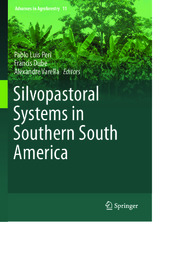Silvopastoral systems in the cold zone of Brazil.
Silvopastoral systems in the cold zone of Brazil.
Resumo: The cold zone of Brazil occupies approximately 6 % of the national territory and is located between latitudes 24° S and 33° S. In this area, extensive cattle and sheep farming systems and conventional cropping and forestry are predominant. With the end of government subsidies by the decade of 1980s, an increase in farming production costs, a decrease of native forest covering, an increase of degraded areas in agriculture and livestock farming systems and a mismatch between timber national supply and demand after 1990s, an opportunity arises for integrate forestry with livestock and agriculture activities in Brazil, particularly in the southern. This chapter initially reports key events over the last three decades that have supported the increasing interest of farmers and enterprises on agroforestry activities, with focus on silvopastoral systems in the cold area of Brazil. Then, relevant advances on silvopastoral systems from research and extension services were reported, highlighting the screening of shaded adapted forage plants and management, trees species screening for silvipastoral systems and animal performance and behaviour under trees. Finally, the chapter analyses the existent opportunities to increase silvopastoral areas in southern Brazil and future challenges for research, development and technology transfer.
Ano de publicação: 2016
Tipo de publicação: Parte de livro (capítulos de livros, trabalhos e resumos publicados em anais ou em coletâneas)
Unidade: Embrapa Clima Temperado
Observações
1 - Por padrão são exibidas publicações dos últimos 20 anos. Para encontrar publicações mais antigas, configure o filtro ano de publicação, colocando o ano a partir do qual você deseja encontrar publicações. O filtro está na coluna da esquerda na busca acima.
2 - Para ler algumas publicações da Embrapa (apenas as que estão em formato ePub), é necessário ter, no celular ou computador, um desses softwares gratuitos. Sistemas Android: Google Play Livros; IOS: iBooks; Windows e Linux: software Calibre.
Acesse outras publicações
Acesse a Base de Dados da Pesquisa Agropecuária (BDPA) para consultar o acervo completo das bibliotecas da Embrapa.

